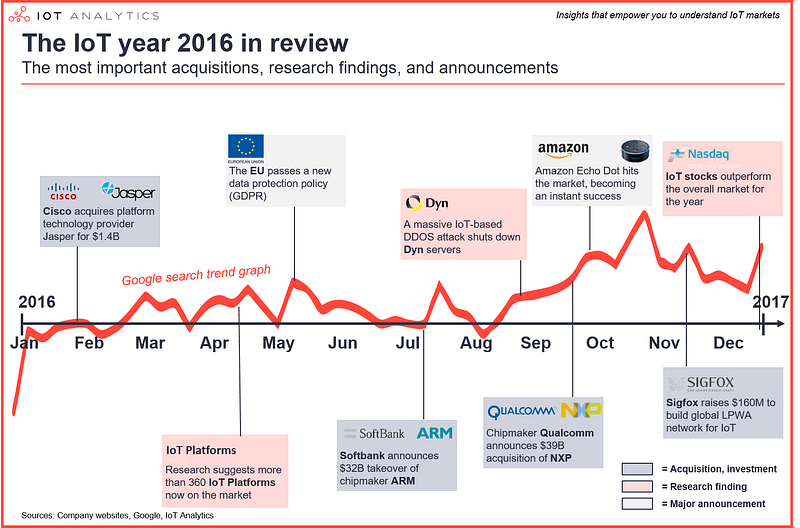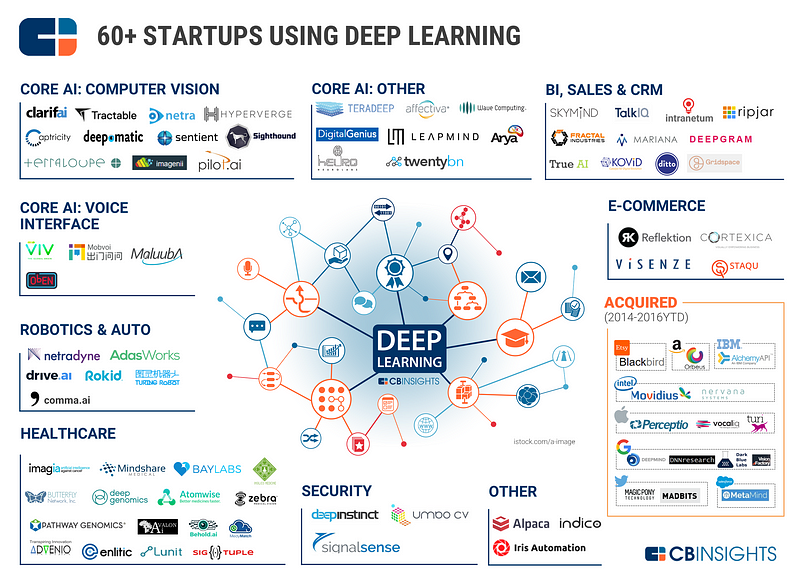Industry Insights
2016 Highlights: IoT, Machine Learning, AI & Automation
From the rise of voice UIs to the Mirai threat, AlphaGo's historic victory to heated debate on automation.
From the rise of voice UIs to the Mirai threat, AlphaGo's historic victory to heated debate on automation.
Happy New Year! Thank you for supporting Last Week in the Future in 2016. This week’s special New Years Edition will feature IoT & ML/AI highlights from 2016 and list trends to watch in 2017.
In 2016, we saw the rise of voice UIs with the success of the Amazon Echo and the Google Home. We also experienced the AR/VR boom with Oculus Rift, HTC, PTC, and Microsoft all pushing more updates on their AR/VR headsets plus the explosive popularity of Pokemon Go. AlphaGo surprised the world when it defeated Lee Sedol to showcase the power of machine learning. Finally, self-driving cars inched towards reality as Uber began picking up customers with autonomous cars in Pittsburgh and also acquired Otto for trucking applications.
IoT also scared the world in many ways. The Mirai attack on Dyn servers took down Twitter and Netflix, alerting everyone that security flaws in IoT devices are critical. Google’s Nest struggled to revolutionize smart homes despite the $3.2 billion acquisition. On the wearable side, smartwatches still struggled to take hold with Pebble dropping out of the race, acquired by Fitbit. Lastly, fragmentation continued to plague IoT in all arenas, from connectivity to the platform level.
Knud Lasse Lueth from IoT Analytics provides an excellent high level overview of major IoT developments in 2016. Aside from the main stories highlighted here, we have summarized the top takeaways for all three levels of IoT:
 Image Credit: IoT AnalyticsImage Credit: IoT Analytics
Image Credit: IoT AnalyticsImage Credit: IoT AnalyticsNvidia still leads the GPU market with its GeForce GTX 1080, 1070, and 1060 graphics cards set to support VR features. Internet giants like Facebook and IBM use Nvidia’s Tesla line of GPUs for machine learning cloud offerings.Intel acquired Nervana Systems and is waiting to close the acquisition of Movidius to launch its AI suite (see LWITF v11.0). Intel’s recent moves adding Altera, Nervana, Phi, and Xeon demonstrate its commitment to supporting hardware for AI/ML applications.Qualcomm acquired car chip maker NXP for $39B, while Softbank bought ARM for $31B. TDK also purchased InvenSense, a sensor supplier, for $1.3B.Particle.io began supporting direct integration with Google Cloud Platform in September, leading the way in accelerated IoT development.
SigFox raised $160M from Intel Capital and Air Liquide in Series E to further deploy their low-power, wide-area (LPWA) networks. SigFox recently announced that it’s now offering coverage in 100 US cities.LoRa chip provider, Senet, also released their coverage map. Coverage is excellent around San Francisco and LA, as expected, but national coverage is still sparse.3GPP finalized specifications for three cellular IoT options: LTE-M1, NB-IoT, and EC-GSM in Q2 of 2016. Both Verizon and AT&T are set to commercialize LTE-M1 networks next year, with NB-IoT getting some serious traction behind Vodafone.Open Connectivity Foundation and AllSeen Alliance merged in October, trimming down the competitive landscape to three players: the newly merged alliance, Intel/Samsung’s Iotivity and Google’s Weave.
IoT platform space is as crowded as ever with IoT Analytics reporting over 400 providers. Cisco made the early splash in February, acquiring platform provider Jasper for $1.4B.Q4 IoT platform research by Forrester Wave listed IBM, PTC, GE, and Microsoft as the leaders in the IoT platform market. SAP, AWS, Cisco, LogMeln, Exosite, Ayla Networks, and Zebra Technologies rounded out the top 11 providers (see LWITF V10.0).The war over voice UI intensified when Samsung acquired Viv, led by the former creator of Apple’s Siri (see LWITF V4.0). With Alexa still in the lead, Google, Apple, and Samsung are vying for some market share in the evolving voice interface market.Big cloud players all shifted their focus to fog/edge computing. Microsoft announced their support for Azure Functions within its IoT Gateway SDK; Amazon announced AWS Greengrass, which provides support for Lambda Functions on IoT devices; and Google launched a developer preview for Android Things, attempting to solve the security issue for IoT products (see Matt Quirion’s “The Big Three Make a Play for the Fog”)
IoT began to take form in 2016, albeit not without some major setbacks. IoT platform and connectivity competition will continue in 2017. Due to the wide array of IoT applications, there are ways for the different standards to co-exist, rather than one completely dominating. The AI-hype will not disappear quickly. Its effects on AR/VR and even MR (mixed reality), along with autonomous driving and retail automation are trends to watch. For a detailed report, see Future Today Institute’s “The Tech Trends You Need to Know for 2017.”
From AlphaGo’s historic victory to record-breaking attendance at NIPS, machine learning continued to be on the forefront of big industry players’ strategy. In LWITF V13.0, we summarized Yann LeCun’s keynote on predictive learning and Tryolab’s summary of unsupervised learning advances in 2016. While deep learning gets all the attention, the fact of the matter is that not everyone is working on the same research topic. Here we list the advances made by each of the key industry players:
 Image Credit: CB InsightsImage Credit: CB Insights
Image Credit: CB InsightsImage Credit: CB InsightsWhile the main headline of 2016 was the success of AlphaGo, DeepMind’s work extends beyond reinforcement learning and training its agents in video games like StarCraft. Differential Neural Computers (DNC) combine deep learning with a memory element to push computers to reason, rather than simply finding patterns (LWITF V5.0). One-shot learning methods give high accuracy even with smaller datasets, perhaps giving smaller companies without access or infrastructure to handle big datasets an opportunity to reap the benefits of deep learning (LWITF V9.0). DeepMind also released WaveNet, a generative model for raw radio.
The New York Times released an excellent article on Google Brain and AI, which was also featured in LWITF V14.0. Machine translation using deep learning architecture now rivals human translation. Google’s focus is definitely on neural networks and deep learning. NLP tools like SyntaxNet and image caption generators based on TensorFlow have all been open-sourced. Google is also exploring the ethics of AI as it published a paper on inherent bias in datasets influencing the results of machine learning (LWITF V4.0).
It’s to be expected that a lab headed by Yann LeCun will focus on convolutional neural networks and image processing. One of the most interesting tools released by FAIR this year was Caffe2Go, a lightweight artistic style transfer tool compatible with mobile devices (featured in LWITF V11.0). Since LeCun publicly praises Generative Adversarial Networks (GANs), it would be interesting to watch FAIR produce more work in Deep Convolutional GANs.
OpenAI is a non-profit AI research company founded by Elon Musk with big name sponsors including Reid Hoffman, Peter Thiel, Microsoft, and AWS. OpenAI researchers proposed InfoGAN model back in August, where the system can generate representations containing information about the dataset in an unsupervised manner.
Microsoft, like Google, works on a variety of machine learning fields. Since introducing deep residual learning for image recognition in 2015, Microsoft delivered in a big way in speech recognition this October. Microsoft’s researcher announced that its systems reached human parity in conversational speech recognition. Azure’s machine learning and cognitive toolkit are also solid products that are more accessible for casual users.
Similar to FAIR’s focus on convolutional neural networks due to Yann LeCun’s influence, MetaMind, headed by Richard Socher, focuses on recurrent neural networks and NLP applications. The Joint Many-Tasks (JMT) model is an end-to-end trainable model able to learn complex NLP tasks. “Adaptive Attention via a Visual Sentinel”, presented at NIPS, involves NLP joined with convolutional neural networks and shows significant improvements in image captioning (LWITF V14.0).
Perhaps shadowed by the news of its acquisition of Otto (self-driving trucks) is Uber’s acquisition of Geometric Intelligence. Not much is known about Geometric Intelligence, but it’s speculated that it was an acqui-hire to position Uber as an AI company. 2017 will be interesting as we await the products of the talent pool hired through Otto and Geometric Intelligence.
While all the major industry players are American, Baidu’s accomplishments cannot be overlooked. Headed by Andrew Ng, Baidu released DeepBench in September, an open source benchmark for testing how fast processors train neural networks. PaddlePaddle, Baidu’s Python-based deep learning framework, showed impressive speech transcription in Chinese.
Apple: Outside of hiring Russ Salakhutdinov from CMU, Apple just started publishing their work. It has also acquired Seattle-based AI startup, Turi earlier this year.
Amazon: Amazon’s machine learning suite is limited compared to Google, Microsoft, and Facebook. However, given the lead Alexa has in the voice market along with the new line of products released at re:Invent this year, Amazon is investing more in this sector.
IBM: It may be fair to say that AlphaGo has surpassed the wow-factor that IBM Watson brought a while back. There’s some news about TrueNorth Neuromorphic Chip being exceptional at image recognition, but not much is known.
Self-driving cars and Amazon Go generated a heated debate on the effects of automation this year. From tech leaders dismissal of job loss to a call for a universal basic income, the general public began to grapple with the consequences of AI.
This topic is so complex that rather than unpacking every component, we provide you with our take on the topic. Regardless of your thoughts on AI, the age of AI is coming, and we need to be prepared.
Hannah White’s “Amazon Go: We’re All F*cked”
Calum McClelland’s “If you think your job is safe from Artificial Intelligence, you’re wrong.”
Yitaek Hwang’s “Artificial Intelligence, Automation, and the Economy”